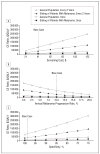Visual screening for malignant melanoma: a cost-effectiveness analysis
- PMID: 17224538
- PMCID: PMC2365732
- DOI: 10.1001/archderm.143.1.21
Visual screening for malignant melanoma: a cost-effectiveness analysis
Abstract
Objective: To evaluate the cost-effectiveness of various melanoma screening strategies proposed in the United States.
Design: We developed a computer simulation Markov model to evaluate alternative melanoma screening strategies.
Participants: Hypothetical cohort of the general population and siblings of patients with melanoma. Intervention We considered the following 4 strategies: background screening only, and screening 1 time, every 2 years, and annually, all beginning at age 50 years. Prevalence, incidence, and mortality data were taken from the Surveillance, Epidemiology, and End Results Program. Sibling risk, recurrence rates, and treatment costs were taken from the literature.
Main outcome measures: Outcomes included life expectancy, quality-adjusted life expectancy, and lifetime costs. Cost-effectiveness ratios were in dollars per quality-adjusted life year (US dollars/QALY) gained.
Results: In the general population, screening 1 time, every 2 years, and annually saved 1.6, 4.4, and 5.2 QALYs per 1000 persons screened, with incremental cost-effectiveness ratios of US dollars 10,100/QALY, US dollars 80,700/QALY, and US dollars 586,800/QALY, respectively. In siblings of patients with melanoma (relative risk, 2.24 compared with the general population), 1-time, every-2-years, and annual screenings saved 3.6, 9.8, and 11.4 QALYs per 1000 persons screened, with incremental cost-effectiveness ratios of US dollars 4000/QALY, US dollars 35,500/QALY, and US dollars 257,800/QALY, respectively. In higher risk siblings of patients with melanoma (relative risk, 5.56), screening was more cost-effective. Results were most sensitive to screening cost, melanoma progression rate, and specificity of visual screening.
Conclusions: One-time melanoma screening of the general population older than 50 years is very cost-effective compared with other cancer screening programs in the United States. Screening every 2 years in siblings of patients with melanoma is also cost-effective.
Figures



Comment in
-
Melanoma screening: focusing the public health journey.Arch Dermatol. 2007 Jan;143(1):101-3. doi: 10.1001/archderm.143.1.101. Arch Dermatol. 2007. PMID: 17224549 Review. No abstract available.
References
-
- Ries LA, Eisner MP, Kosary CL, et al. SEER Cancer Statistics Review, 1975–2000. Bethesda, Md: National Cancer Institute; 2003.
-
- Weir HK, Thun MJ, Hankey BF, et al. Annual report to the nation on the status of cancer, 1975–2000, featuring the uses of surveillance data for cancer prevention and control [published correction appears in J Natl Cancer Inst. 2003;95:1641] J Natl Cancer Inst. 2003;95:1276–1299. - PubMed
-
- Tsao H, Rogers GS, Sober AJ. An estimate of the annual direct cost of treating cutaneous melanoma. J Am Acad Dermatol. 1998;38:669–680. - PubMed
-
- Atlanta, Ga: American Cancer Society; 2006. [Accessed March 13, 2006]. Cancer Facts and Figures. http://www.cancer.org/downloads/STT/CAFF2006PWSecured.pdf.
-
- Ford D, Bliss JM, Swerdlow AJ, et al. The International Melanoma Analysis Group (IMAGE) Risk of cutaneous melanoma associated with a family history of the disease. Int J Cancer. 1995;62:377–381. - PubMed
Publication types
MeSH terms
Grants and funding
LinkOut - more resources
Full Text Sources
Medical

